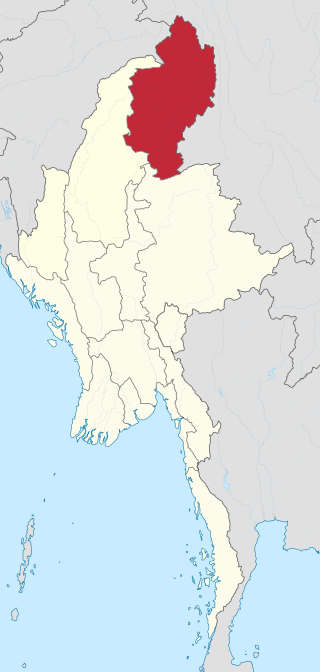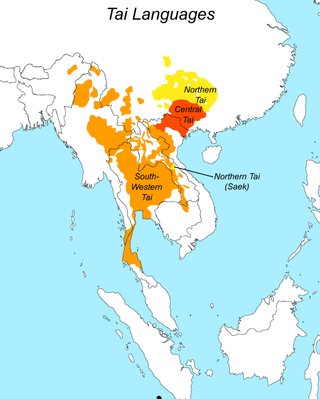Related Research Articles
The Lisu people are a Tibeto-Burman ethnic group who inhabit mountainous regions of Myanmar (Burma), southwest China, Thailand, and the Indian state of Arunachal Pradesh.

The Jingpo people are an ethnic group who are the largest subgroup of the Kachin peoples. The greater name for all the Kachin peoples in their own Jingpo language is the Jinghpaw. Other endonyms include Zaiwa, Lechi, Lisu, Maru, Hkahku,

Kachin State is the northernmost state of Myanmar. It is bordered by China to the north and east ; Shan State to the south; and Sagaing Region and India to the west. It lies between north latitude 23° 27' and 28° 25' longitude 96° 0' and 98° 44'. The area of Kachin State is 89,041 km2 (34,379 sq mi). The capital of the state is Myitkyina. Other important towns include Bhamo, Mohnyin and Putao.

The Tai, Zhuang–Tai, or Daic languages are a branch of the Kra–Dai language family. The Tai languages include the most widely spoken of the Tai–Kadai languages, including Standard Thai or Siamese, the national language of Thailand; Lao or Laotian, the national language of Laos; Myanmar's Shan language; and Zhuang, a major language in the Southwestern China's Guangxi Zhuang Autonomous Region, spoken by the Zhuang people (壯), the largest minority ethnic group in China, with a population of 15.55 million, living mainly in Guangxi, the rest scattered across Yunnan, Guangdong, Guizhou and Hunan provinces.

The Nùng are a Central Tai-speaking ethnic group living primarily in northeastern Vietnam and southwestern Guangxi. The Nùng sometimes call themselves Thổ, which literally means autochthonous. Their ethnonym is often mingled with that of the Tày as Tày-Nùng. According to the Vietnam census, the population of the Nùng numbered about 856,412 by 1999, 968,800 by 2009, and 1,083,298 by 2019. They are the third largest Tai-speaking group, preceded by the Tày and the Thái, and sixth overall among national minority groups.
Hill tribe is a term used in Thailand for all of the various ethnic groups who mostly inhabit the high mountainous northern and western regions of Thailand, including both sides of the border areas between northern Thailand, Laos and Burma, the Phi Pan Nam Range, the Thanon Range, the latter a southern prolongation of the Shan Hills, as well as the Tenasserim Hills in Western Thailand. These areas exhibit mountainous terrain which is in some areas covered by thick forests, while in others it has been heavily affected by deforestation.

The Tày people, also known as the Thổ, T'o, Tai Tho, Ngan, Phen, Thu Lao, or Pa Di, are a Central Tai-speaking ethnic group who live in northern Vietnam. According to a 2009 census, there are 1.7 million Tày people living in Vietnam. This makes them the second largest ethnic group in Vietnam after the majority Kinh (Vietnamese) ethnic group. Most live in northern Vietnam in the Cao Bằng, Lạng Sơn, Bắc Kạn, Thái Nguyên, and Quảng Ninh provinces, along the valleys and the lower slopes of the mountains. They also live in some regions of the Bắc Ninh and Bắc Giang provinces. They inhabit fertile plains and are generally agriculturalists, mainly cultivating rice. They also cultivate maize, and sweet potato among other things.

The known early history of Thailand begins with the earliest major archaeological site at Ban Chiang. Dating of artifacts from this site is controversial, but there is a consensus that at least by 3600 BCE, inhabitants had developed bronze tools and had begun to cultivate wet rice, providing the impetus for social and political organisation.
Dulong or Drung, Derung, Rawang, or Trung, is a Sino-Tibetan language in China. Dulong is closely related to the Rawang language of Myanmar (Burma). Although almost all ethnic Derung people speak the language to some degree, most are multilingual, also speaking Burmese, Lisu, and Mandarin Chinese except for a few very elderly people.

There are approximately a hundred languages spoken in Myanmar. Burmese, spoken by two-thirds of the population, is the official language.

The peopling of Thailand refers to the process by which the ethnic groups that comprise the population of present-day Thailand came to inhabit the region.
The Daai are an ethnic group living in Chin State, Myanmar. The Daai consist of 32 Chin tribes, which have been registered by the Government of Burma since 1890. The recent Military Regime’s census mentions the Daai tribe as the 62nd of 135 tribes of Burma. Researchers refer to them as the Daai group in the ethnic survey book of Burma. The Daai Chin appear to be of Mongolian, Indo-Chinese, and Tibeto-Burman descent. The Daai people live in the Mindat, Paletwa, Matupi and Kanpetlet townships of Southern Chin State in Burma. There are more than 180 Daai villages with a total population of somewhere between 40,000 and 50,000. Their population makes the Daai-Chin the majority tribe of the Southern Chin Hills.
The Nung or Nungish languages are a poorly described family of uncertain affiliation within the Sino-Tibetan languages spoken in Yunnan, China and Burma. They include:
Southern Anung is a Sino-Tibetan language spoken by the Nung people in Fugong County, China, and Kachin State, Myanmar. The Anung language is closely related to the Derung and Rawang languages. Most of the Anung speakers in China have shifted to Lisu, although the speakers are classified as Nu people. The Northern Anung people speak a dialect of Derung, which is also called Anung, but is not the same Anung discussed in this article.
Hkamti District or Khamti District is a district in northern Sagaing Division of Burma (Myanmar). Its administrative center is the town of Singkaling Hkamti.
Rawang, also known as Krangku, Kiutze (Qiuze), and Ch’opa, is a Sino-Tibetan language of India and Burma. Rawang has a high degree of internal diversity, and some varieties are not mutually intelligible. Most, however, understand Mutwang (Matwang), the standard dialect, and basis of written Rawang.

The Chinese Nùng are a group of ethnic Han Chinese living in Vietnam. The Chinese Nùng composed 72% to 78% of the population of the Nung Autonomous Territory of Hai Ninh (1947–1954) located in the Vietnamese Northeast, covering parts of the present-day Quảng Ninh and Lạng Sơn provinces.

The Nùng Autonomous Territory, also known as the Hải Ninh Autonomous Territory, the Nùng Hải Ninh Autonomous Territory, and the Nùng country, abbreviated as TAN, was an autonomous territory for the Chinese Nùng within the French Union created during the First Indochina War by the French colonial government in Indochina. During this period the French hoped to weaken the position of the Việt Minh by granting more autonomy to ethnic minorities in Vietnam in the hopes of getting more support from them in their fight against the predominantly Kinh Việt Minh, which took control of large parts of Vietnam following the August Revolution and the power vacuum that occurred following the surrender of Japan at the end of World War II.

The Nong Zhigao rebellions were three uprisings in 1042, 1048, and 1052 led by the Zhuang/Tai Nùng leader Nong Zhigao against the Viet kingdom of Đại Cồ Việt (968–1054) and the Song dynasty (960–1279) of China. Defeated in 1042 and 1048 by Đại Cồ Việt, Zhigao fled to Song territory where he tried to set up an independent kingdom by taking Guangzhou. He failed and was forced to flee to the Dali Kingdom in 1054.
References
- 1 2 Wang, Ann (8 June 2016). "The Rawang and their land". Frontier Myanmar. Retrieved 13 November 2023.